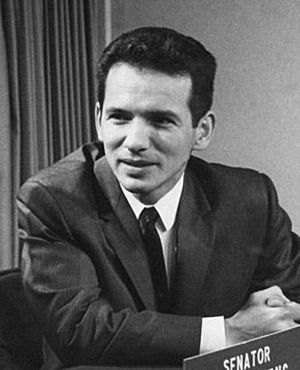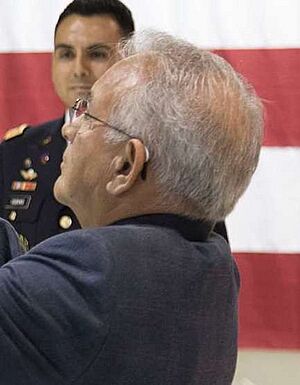Emil Notti facts for kids
Quick facts for kids
Emil Notti
|
|
|---|---|

Notti in 1969
|
|
| 1st President of the Alaska Federation of Natives | |
| In office 1967–2016? |
|
| Preceded by | Office established |
| Succeeded by | Julie Kitka |
| Personal details | |
| Born |
Emil Reynold Notti
March 11, 1933 Koyukuk, Alaska, U.S. |
| Political party | Democratic |
| Education | Northrop University (BS) |
| Occupation |
|
Emil Reynold Notti, born on March 11, 1933, is an important leader from Alaska. He is an engineer, a businessman, and a government official. He is also a strong voice for Koyukon Athabaskan people, who are Indigenous to Alaska. Notti played a huge role in creating the Alaska Native Claims Settlement Act (ANCSA), which was a major law that helped Alaska Native people get back their land and rights.
Contents
Early Life and Learning
Emil Notti was born in Koyukuk, Alaska. He studied hard and earned a Bachelor of Science degree in aeronautical and electrical engineering from Northrop University in California. He also has special honorary degrees from Alaska Pacific University and the University of Alaska Anchorage. Before his career, Notti served in the United States Navy during the Korean War.
Helping Alaska Natives: ANCSA and AFN
Emil Notti was a key person in developing the Alaska Native Claims Settlement Act (ANCSA). This important law was signed by President Richard Nixon on December 18, 1971. At the time, it was the largest land claims agreement in United States history.
ANCSA was created to solve long-standing problems about land ownership for Alaska's Indigenous people. For over a century, Native people in Alaska had been working to secure their land rights. This act also aimed to help Alaska's economy grow.
Notti was the very first President of the Alaska Federation of Natives (AFN). He also served as the third President of Doyon, a regional corporation that owns a lot of land – about 12.5 million acres.
The Alaska Federation of Natives
In 1966, Notti called for a big meeting in Alaska. He invited many leaders from across the state to come together. This first meeting happened on October 18, 1966, which was exactly 99 years after Alaska was transferred from Russia to the United States.
Notti led the three-day meeting. They talked about land recommendations, land claims, and the political challenges of getting a new law through Congress. The growing presence and political importance of Native people became clear when their leaders were elected to the state legislature. Members of the group gained seven out of sixty seats in the legislature.
When the group met again in early 1967, they had a new name: The Alaska Federation of Natives. Emil Notti became their first full-time President.
Why ANCSA Was Needed
Before ANCSA, Native people in Alaska faced many difficulties. After the Alaska Purchase by the United States in 1867, Alaska was still considered a territory. The agreement to buy Alaska was made so quickly that it didn't clearly define the rights of Native people or their land ownership. It wasn't until 1959 that Alaska officially became a state.
During hearings in Fairbanks and Anchorage in 1969, before ANCSA was passed, Notti spoke up. He argued that the money proposed in the bill was not enough. He said, "The $500 million in our bill may seem like a lot of money, but after looking at the conditions in our villages, $500 million will only give our Native people a chance to operate on a standard of living of what we consider basic minimums." In its final version, ANCSA granted Alaska Native people over $900 million.
The ANCSA law included about 44 million acres of land and $962.5 million. This land and money were given to twelve Alaska Native regional corporations and over 200 local village corporations. The village corporations received the rights to the surface of the land, while the regional corporations received the rights to what was beneath the surface.
Notti also cast the tie-breaking vote to include Sealaska and Tlingit and Haida into the Alaska Federation of Natives. This important vote brought $7.2 million and 290,000 acres of land to Native Corporations in Southeast Alaska. Today, the twelve regional Native corporations and many village corporations employ around 58,000 people. They create thousands of jobs for both Native and non-Native Alaskans.
Other Important Roles
Besides his work on ANCSA and with AFN, Emil Notti had many other important jobs. He worked for Autonetics, a part of North American Aviation, on the LGM-30 Minuteman project during the Cold War.
Later, he served under several Alaska Governors, including Bill Sheffield and Sarah Palin. He held roles such as Deputy Commissioner of Health and Social Services, Commissioner of Community and Regional Affairs, and Commissioner of Commerce, Community and Economic Development.
Notti also served on many important boards, including the National Bank of Alaska and the Alaska Railroad. He was also on the Board of Trustees for APFC, which manages a large fund for Alaska.
In 1973, Notti ran for Congress as the Democratic candidate for Alaska. He lost that election by a small number of votes to Don Young.
Later Years and Continued Work
After ANCSA was passed, Notti continued his career with AFN. He eventually became the CEO of Doyon, Limited. He also continued to serve as Commissioner of Commerce & Economic Development and Commissioner of Community & Regional Affairs for Alaska.
In March 2022, Notti announced he would run again for Congress in a special election for Alaska's at-large congressional district. This election happened after Don Young passed away. Notti did not win the primary election, but he supported Mary Peltola, who eventually won the election.


